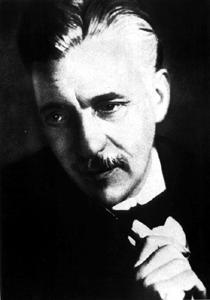Ilya Golosov
| Ilya Alexandrovich Golosov | |
|---|---|
 |
|
| Born |
July 31, 1883 Moscow |
| Died | January 29, 1945 (aged 61) Moscow |
| Nationality | USSR |
| Occupation | Architect |
| Practice | Mossovet Architectural Workshop No.4 (since 1933) |
| Buildings | Zuev Workers' Club, Yauzsky Boulevard apartment building (Moscow), Communal housing (Ivanovo) |
| Projects | Entries to 1926 competitions (Rusgertorg, Electrobank etc.) |
Ilya Alexandrovich Golosov (1883 in Moscow – 1945 in Moscow) was a Russian Soviet architect. A leader of Constructivism in 1925-1931, Ilya Golosov later developed his own style of early stalinist architecture known as postconstructivism. Не was a brother of Panteleimon Golosov.
Golosov studied in the Stroganov School of Arts and Moscow School of Painting, Sculpture and Architecture, graduating in 1912. Before World War I, he trained in the workshops of Igor Grabar and Alexey Shchusev, and collaborated with Marian Peretyatkovich and Ivan Rerberg on Northern Insurance Buildings (Moscow). In 1914-1917 Golosov served as a military engineer. In 1918, Golosov joined Moscow state architectural office led by neoclassicist Ivan Zholtovsky, and stayed with him throughout the Civil war, at the same time teaching at the MVTU and VKhUTEMAS.
Golosov's work during the Civil War and first years of New Economic Policy was limited to city planning projects, landscaping and repairs. A decade of hostilities (1914–1922) caused an unexpected outcome for the profession and Golosov brothers personally: their first chance to build anything emerged when they were already 40 years old. The "new generation" were, in fact, mature men with classic prerevolutionary training; the next generation (Ivan Leonidov and the class of 1929) was just beginning their college training.
...
Wikipedia
